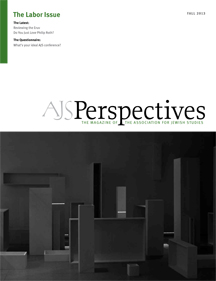
So, do I love Roth, and do you? Well, as I told my neighbor at the Film Forum, it’s complicated. I have been reading and working on Roth for many, many years (first book? Portnoy’s Complaint, read in Murray Baumgarten’s Jewish American Literature course at UC Santa Cruz around 1987). I have been very, very frustrated at times not only with his problematic (this overused word is an understatement) representations of women but also with his attacks on feminists, his queasy-making depictions of queer women, not to mention the totemic manner through which black characters are consistently plunked throughout his texts (more on all of this in my book, Jewish Anxiety: Philip Roth). Not to mention the fact that, were I to review his entire oeuvre (ok, at time of writing I am a few shy of having read all thirty-one novels) I would say his prose is full of brilliant sentences, turns of phrase, and released neuroses, but he should have redacted and condensed more, and written less. As Roth himself told us at the conference, “I’m far from liking all the pages I’ve written.” So, do I love Roth? Yes, most of his prose I love.
Roth’s announcement in Les inrocks that he was retiring from writing (“Némésis sera mon dernier livre.”) predated the spectacular Roth@80 conference. Of course, the planning of the conference predated his surprise retirement (and just as a side note many people at the conference fully expect Roth to write another novel). So there was much reference made to this new turn in his long career. The first day of the conference, on March 18, 2013 at the Robert Treat Hotel in Roth’s hometown of Newark, followed a traditional academic format with simultaneous sessions of panels consisting of two or three papers. I heard some excellent essays on queering Roth (David Brauner), Roth’s Newark (Michael Kimmage), Roth and Joyce (David Stone), Death and Roth (Debra Shostak), and many other wonderful essays by established and emerging scholars, as well as looser roundtable discussions by Aimee Pozorski, Pia Masiero, Dean Franco, Bernard Rogers, Benjamin Schreier, Ezra Cappell, and others. It was marvelous to be in the same room with so many other people who inhabit the same imaginative headspace and who can understand any reference to (or any joke about) any moment in any of Roth’s novels.
The second day of the conference, on the day of Roth’s eightieth birthday, had an entirely different flavor. It began at the glorious Newark Public Library, designed by Rankin and Kellogg and considered one of the crown jewels of Newark civic architecture in 1901. The day ended with a reception, a series of talks by writers and friends of Roth and then Roth himself, followed by a birthday toast and cake. All of these took place at another crown jewel of Newark’s former glory, the Newark Museum, which opened in 1909, and is enhanced by a capacious and elegant courtyard. At the library a carefully curated exhibit about Roth ringed the second floor. Photographs of Roth in his military garb, Roth as a young boy, Roth with Ben-Gurion, Obama, and Clinton, Roth’s parents and grandparents, and so on were paired with apt quotations from Roth’s works. Then, we gathered into three big busses and set off on a tour of Roth’s Newark. Our tour guide was Liz Del Tufo, the president of the Newark Preservation and Landmarks Committee, who is dedicated to resurrecting or at least delaying the destruction of some of the great dinosaurs of the Newark of Roth’s era. And they deserve all the attention they can garner. On the tour, in addition to stopping at Roth’s former home, Roth’s high school, and other points of Rothian interest, we passed many marvelous old mansions with boarded up windows, surrounded by barbed wire, and looking very sorry indeed.
Before the conference I was deeply worried that the question “so, do you love Roth,” would be answered with an unqualified yes by everyone there, that there would be general unruffled sycophantic attachment, and that my complicated, ambivalent, relationship with Roth would have to be quashed. Despite the fact that we were all scholars, one possibility floated when we were wondering what we might say if we were granted the opportunity to shake Roth’s hand was “I’m a fan of your work.”
For the record, I blew my chance to shake his hand because of my sneakers. When I arrived at the museum, Roth was standing there, chatting with someone and that was my chance. But I was wearing jeans and sneakers, so felt wrongly attired for the moment. What would I have said anyway? “I have been frustrated by your work for decades.” “Your prose is glorious and brilliant but I wish you’d written less.” “Reading Sabbath’s Theater made me want to sequester my two little girls to keep them safe from the likes of Mickey Sabbath with all his admiration for his ancient Italian teacher with the twelve-year-old girlfriend!” “What do you think of the current title of my book, Jewish Anxiety: Philip Roth?” “What is Jewish Anxiety?” I mean, really what could I possibly have said in one sentence that would encapsulate all that ambivalence and confusion? By the time I had donned my conference dress, Roth had been whisked away for the VIP dinner and then, later, he was preceded by a fragment of the band from Weequahic High School and surrounded by well-wishers, TV cameras, etc. The reception before Roth’s speech included such literati as Nathan Englander, Jonathan Safran Foer, Nicole Krauss, Don DeLillo, Paul Auster and doubtless others I would have recognized by name but not by sight. It was quite a spectacular gathering of birthday celebrants.
We assembled in the auditorium of the museum and the first speaker, Jonathan Lethem, spun a gorgeous narrative about The Breast, his first Roth novel, which he’d read while vacationing in the Hamptons with a rich girl into whose pants he couldn’t get. His remarks, which he cleverly titled, “CounterRoth,” noted that all American writers have to contend with Roth and that the latter had “closed the gap between Bellow and Mad magazine” and elicited a “strongly opinionated, half-aggrieved love.” So, do you love Roth, Mr. Lethem? The answer would be a qualified yes and Lethem seemed to support the argument of the queering Roth essay I’d heard the day before when he closed with, “The only breast I fondled in Southhampton was Roth’s.”
After Lethem, Hermione Lee delivered an eloquent speech about Shakespeare in Roth, Claudia Roth Pierpont spoke about three undertheorized aspects of Roth’s writing: music, silverware, and women. I would agree with her about the first two but not about the third, although I don’t agree with myself about the third . . . or rather, I can’t decide, or rather I have been so aggrieved for so long, so pissed off so often, that I can’t believe I am even struggling to articulate what is problematic about gender in Roth. Claudia Roth Pierpont’s suggested that many of Roth’s female characters are more complex than is often noted. Pierpont thickly described George Ziad’s wife, Anna, from Operation Shylock, then noted that when she asked Roth about her he said he wanted to “reverse the stereotype.” Yet Roth describes Anna as a “tiny, almost weightless woman” whose “intense and globular” eyes were “set like a lemur’s in a triangular face not very much larger than a man’s fist” (140). This description seems to defy the thick one Pierpont wanted to cull from it; not only is she literally “anorexic” (140) but the scalar comparison of her face with a man’s fist seems to make her ripe for a punch. Pierpont went on to tell us that, in a “snippy” mood, she phoned Roth to complain about Jamie in Exit Ghost because with her expensive cashmere sweaters casually slung over lingerie “she’s kind of perfect.” Roth replied: “You should hear what she says about you.”
Then, after Alain Finkelkraut performed a reading of Nemesis (supposedly Roth’s last novel), Edna O’Brien introduced Roth by recounting a series of recollections of her time with him. He pounded on her door in a rage one day because during rehearsals for his then-wife Claire Bloom’s play The Cherry Orchard (which appears in Sabbath’s Theater, 389–90) in London, Roth was not sufficiently consulted. Thinking that fresh air might calm the angry author, O’Brien took him to the park whereupon he flung himself down on the wet grass. When she had first met Roth, at a dinner party at her house, he had attempted (unsuccessfully) to address her in an Irish accent. “It has been assumed we were lovers, I have to confess to you that we were not,” O’Brien continued, and then, “there is a misconception that Roth does not like women; well he may not like women, but he certainly loves them.” When O’Brien had asked Roth about his relationship with his mother, whether she loved him—yes, she did—Roth had emphatically replied, and “I was too adorable for words.”
Then Roth took the stage. He began his remarks by asking O’Brien to confirm that she had told the story of him flinging himself down on the grass and noting that the author of Portnoy’s Complaint doesn’t need to be thought of as any more childish. Roth then began by speaking about all he would not speak about, using the rhetorical trope of proslipsis. (Just as I was making a note to myself to email someone from my former rhetoric department to find out what this trope was called Roth announced that his friend Alain Finkelkraut had told him it was either paralipsis or proslipsis.) Each of the moments of proslipsis was amplified and made visceral by the memories of the tour. As Roth told us he wouldn’t tell us about riding his bike to the Weequahic branch of the library and returning home with a basket full of books, I could see in my mind’s eye the route he would have taken through the “tidy” (this was our tour guide’s word) single family homes of his childhood haunts. Then, after describing all the things he would not describe from the Newark of the 1940s, he closed by reading sections from a long passage from Sabbath’s Theater (694–711), among Roth’s most marvelous novels. “I’ve described my last breast, you’ll be glad to know,” he told us, riffing on Lethem’s story.
The passage begins at the cemetery where Sabbath looks for his family and includes a series of ruminations on the gravestones: “Our beloved mother Minne. Our beloved husband and father Sidney . . .” (705); it ends with, “Here I am,” as though Roth were throwing a gauntlet down to death and defying us to make an epitaph for him. Later in Sabbath’s Theater, Sabbath bitterly imagines his own gravestone: “Beloved Whoremonger, Seducer, Sodomist, Abuser of Women, Destroyer of Morals, Ensnarer of Youth, Uxoricide, Suicide 1929–1994” (716).
At one point in Philip Roth: Unmasked Roth is asked where he plans to be buried. Roth replies that if he revealed this information the day after his death, his grave would be flooded with teeny boppers. Beloved writer?

